Living with Parkinson’s disease presents unique challenges that extend far beyond the widely recognized tremors.
For millions of individuals diagnosed with this progressive neurological condition, something as fundamental as eating a meal can become a source of frustration, embarrassment, and even danger.
Research from PubMed indicates that up to 95% of people with Parkinson’s disease experience some form of eating difficulty during the course of their illness, ranging from mild tremor-related spills to severe swallowing complications such as dysphagia.
Dysphagia in Parkinson’s disease can lead to malnutrition and aspiration pneumonia, significantly affecting quality of life and increasing mortality risk.
The impact of Parkinson’s disease dining aids extends beyond physical symptoms. The social and emotional aspects of shared meals, which form the cornerstone of family life and social interaction, can become sources of anxiety and isolation.
However, with the right combination of specialized eating utensils for Parkinson’s, occupational therapy guidance, and adaptive strategies, individuals with Parkinson’s disease can maintain their independence, dignity, and nutritional health throughout their journey with this condition.
This comprehensive guide explores the specific challenges Parkinson’s disease presents during mealtimes and provides evidence-based solutions through carefully selected adaptive dining aids.
By understanding how tremors, rigidity, and other motor symptoms affect eating, patients and caregivers can make informed decisions about the best eating utensils for Parkinson’s patients at every stage of the disease.
UNDERSTANDING PARKINSON’S DINING CHALLENGES
Parkinson’s disease affects the nervous system in ways that create a complex web of dining difficulties.
The condition primarily damages dopamine-producing neurons in the brain, leading to motor symptoms that significantly impact the ability to eat safely and comfortably.
Understanding these challenges is crucial for selecting appropriate interventions and adaptive equipment.
Tremor-Related Difficulties
The most visible symptom of Parkinson’s disease, tremor, occurs in approximately 70% of patients.
However, not all tremors are the same, and their impact on dining varies significantly.
Resting tremors, which occur when muscles are relaxed, may actually improve during the act of eating as the intentional movement can temporarily suppress the tremor.
Conversely, action tremors, which occur during voluntary movement, can make it nearly impossible to bring food to the mouth without spillage.
The frequency and amplitude of tremors fluctuate throughout the day, often correlating with medication timing.
This phenomenon, known as “on-off” periods, means that a person may eat successfully during peak medication effectiveness but struggle significantly when medication levels drop.
Understanding these patterns helps caregivers and patients time meals appropriately and select utensils that provide stability during challenging periods.
Motor Control Complications
Beyond tremors, Parkinson’s disease presents several other motor symptoms that affect dining.
Bradykinesia, or slowness of movement, makes the entire eating process more time-consuming and can lead to food cooling before consumption is complete.
This symptom also affects the ability to cut food efficiently, coordinate utensil use, and maintain proper posture during meals.
Rigidity, another hallmark of Parkinson’s disease, creates muscle stiffness that limits the range of motion in joints.
This can make it difficult to bring utensils to the mouth, particularly when rigidity affects the shoulders, elbows, or wrists.
The combination of rigidity and bradykinesia often results in a shuffling, hesitant approach to eating that can be both physically exhausting and emotionally discouraging.
Postural instability, while more pronounced in advanced stages of Parkinson’s disease, can affect dining posture and balance while seated.
This instability can lead to difficulty maintaining proper positioning for safe swallowing and may require additional support systems beyond adaptive utensils.
Non-Motor Symptoms Affecting Nutrition
Parkinson’s disease extends beyond motor symptoms to include non-motor complications that significantly impact nutrition and dining.
Dysphagia, or difficulty swallowing, occurs in up to 80% of people with Parkinson’s disease and presents serious safety concerns.
This condition can make certain food textures dangerous and may require dietary modifications in addition to adaptive utensils.
Cognitive changes, including executive function difficulties and attention problems, can make meal planning and preparation challenging.
These changes may also affect the ability to learn new adaptive techniques or remember to use specialized utensils consistently.
Gastrointestinal symptoms, including delayed gastric emptying and constipation, can affect appetite and meal timing.
These symptoms often interact with medication schedules, creating additional complexity in meal planning and nutrition management.
OCCUPATIONAL THERAPY INSIGHTS FOR PARKINSON’S DINING
Occupational therapists play a crucial role in addressing dining challenges for people with Parkinson’s disease.
Their expertise in analyzing daily living activities and recommending adaptive equipment makes them invaluable partners in maintaining nutritional independence.
Professional Assessment and Intervention
A comprehensive occupational therapy evaluation for dining difficulties includes assessment of fine motor skills, hand strength, range of motion, and cognitive function as they relate to eating tasks.
Therapists also evaluate swallowing safety, often in conjunction with speech-language pathologists, to ensure that adaptive equipment recommendations align with dysphagia management needs.
The timing of occupational therapy intervention is crucial. Early intervention, ideally shortly after diagnosis, allows patients to learn adaptive techniques while motor function is still relatively preserved.
This proactive approach helps establish successful patterns before symptoms progress and makes the transition to more specialized equipment smoother.
Occupational therapists also consider the progressive nature of Parkinson’s disease in their recommendations.
Rather than simply addressing current difficulties, they anticipate future needs and may recommend equipment that can be modified or upgraded as symptoms advance.
This forward-thinking approach helps families invest in solutions that will provide long-term value.
Therapeutic Approaches and Strategies
Beyond equipment recommendations, occupational therapists provide valuable training in compensatory techniques.
These may include timing meals with medication peaks, using larger plates with raised edges to prevent food from sliding, and implementing rest periods during longer meals to manage fatigue.
Environmental modifications often accompany equipment recommendations.
Therapists may suggest optimal lighting to compensate for visual changes, appropriate seating height and support, and table modifications that improve accessibility and comfort during meals.
The integration of adaptive equipment with therapeutic exercises is another key component of occupational therapy intervention.
Therapists may prescribe specific exercises to maintain hand strength and dexterity, recommend stretching routines to address rigidity, and provide training in energy conservation techniques that make mealtimes less exhausting.
SPECIALIZED UTENSILS FOR PARKINSON’S DISEASE
The selection of appropriate eating utensils for Parkinson’s requires careful consideration of specific symptoms and individual needs.
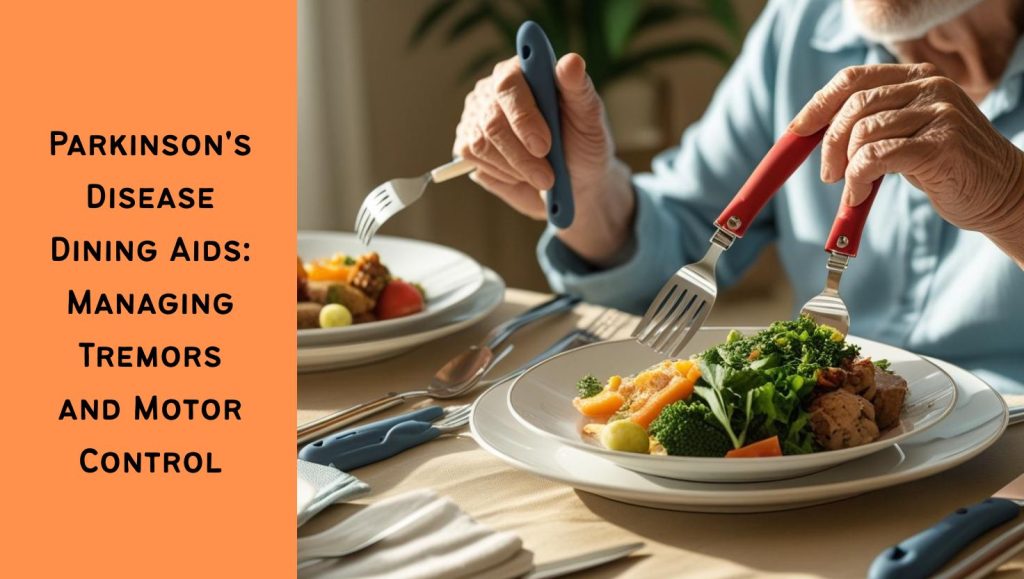
Unlike general adaptive equipment, utensils designed for Parkinson’s disease must address the unique combination of tremors, rigidity, and progressive motor decline that characterizes this condition.
Weighted Utensils for Tremor Control
Weighted utensils represent one of the most effective interventions for tremor-related dining difficulties.
The additional weight, typically 8-10 ounces per utensil, provides proprioceptive feedback that helps stabilize hand movements and reduces the amplitude of tremors during eating.
This increased weight works on the principle of momentum, making it more difficult for tremors to disrupt the smooth movement of the utensil.

The effectiveness of weighted utensils varies among individuals and may change as the disease progresses. Some patients find significant benefit from weighted options, while others may find them too heavy to manage comfortably.
The key is finding the right balance between tremor control and manageable weight, which often requires trial and experimentation under professional guidance.
Modern weighted utensils are designed with ergonomic considerations that extend beyond simple weight addition.
Many feature balanced weight distribution that prevents the utensil from becoming top-heavy, comfortable grip surfaces that accommodate reduced hand strength, and designs that work effectively for both right- and left-handed users.
Ergonomic Handle Designs
The grip difficulties associated with Parkinson’s disease require utensils with specially designed handles that accommodate reduced hand strength and limited finger dexterity.
Built-up handles, typically 1.5 to 2 inches in diameter, reduce the need for precise finger positioning and allow for a more comfortable grip that doesn’t require significant hand strength.
Textured surfaces on utensil handles provide additional grip security, particularly important for individuals experiencing both tremors and reduced tactile sensation.
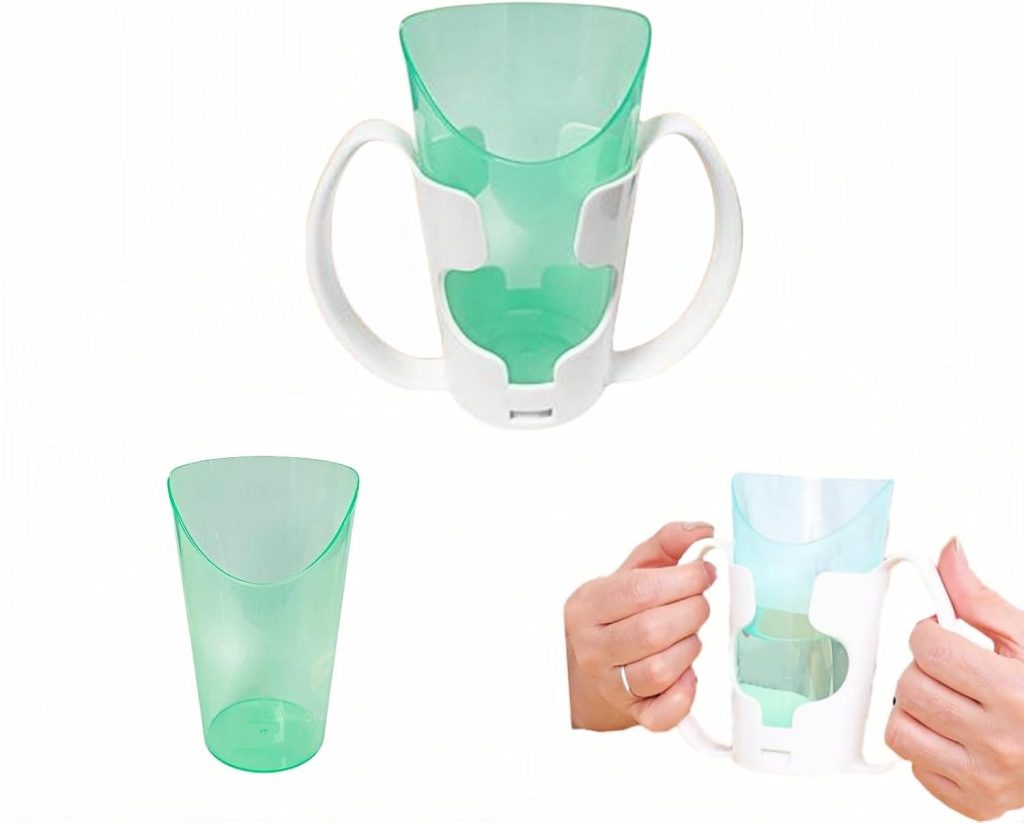
These textures range from soft, rubberized coatings to more aggressive grip patterns, allowing for customization based on individual preferences and needs.
Some ergonomic designs incorporate finger guides or indentations that help position the hand correctly on the utensil.
These features are particularly beneficial for individuals experiencing cognitive changes that affect motor planning and execution.
The guides provide tactile cues that help maintain proper grip without requiring conscious effort.
Stabilizing Features and Adaptive Designs
Modern adaptive utensils incorporate various stabilizing features that address the multiple challenges of Parkinson’s disease.
Anti-slip bases on plates and bowls work in conjunction with specialized utensils to create a stable eating system.
These bases may use suction cup technology or weighted designs to prevent dishes from sliding during use.
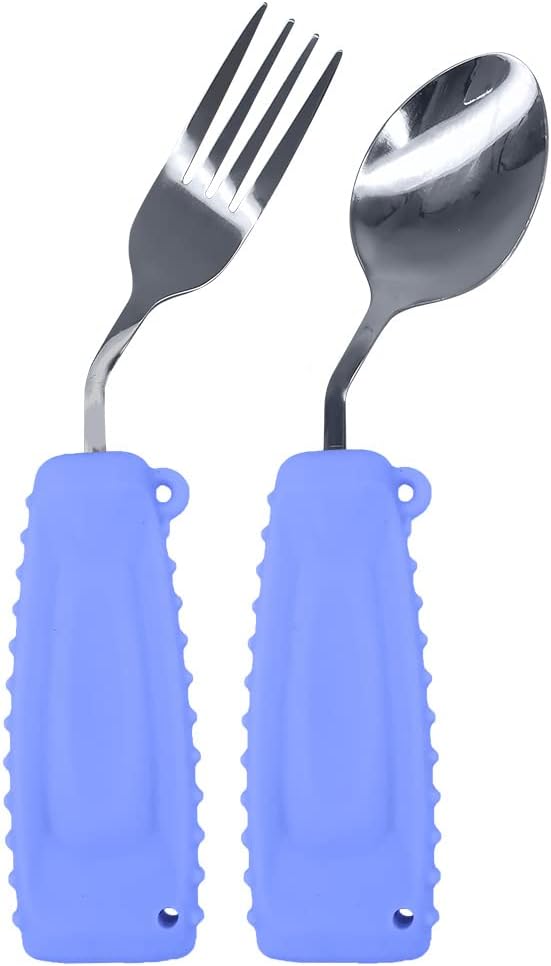
Bendable utensils offer a unique solution for individuals with limited range of motion due to rigidity or postural changes.
These utensils can be bent to accommodate individual eating patterns and positioning needs, potentially eliminating the need for difficult arm movements that trigger tremors or cause fatigue.
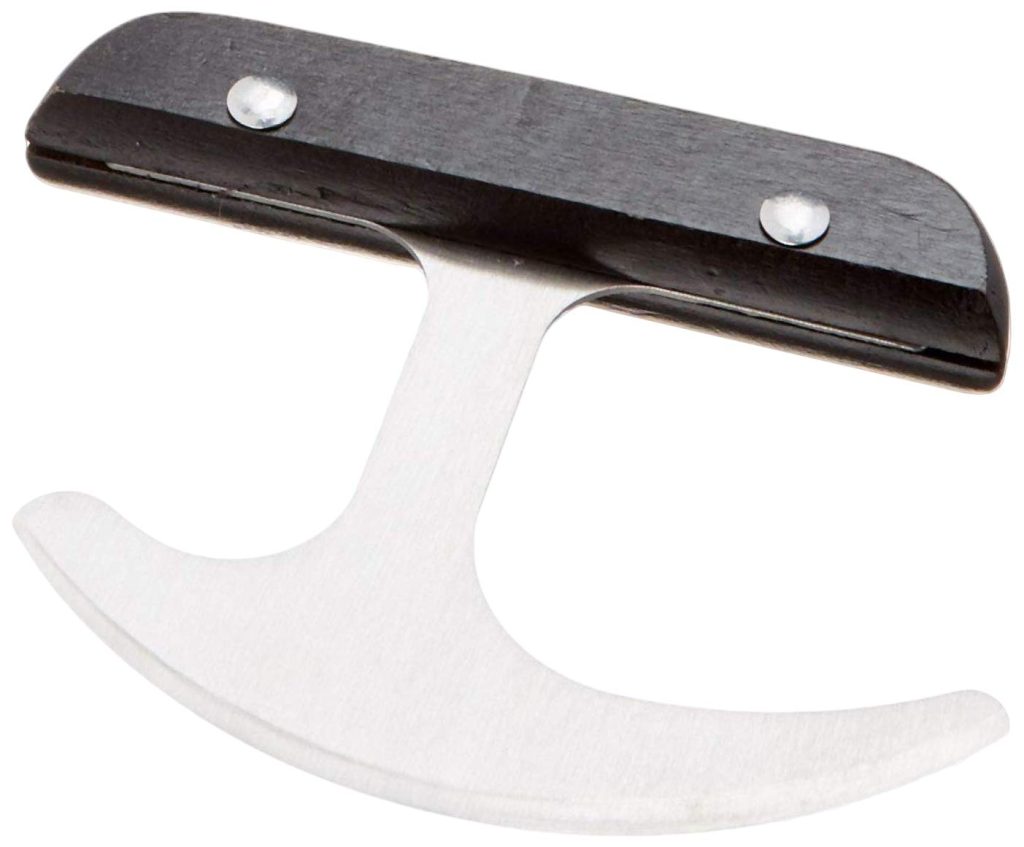
Rocker knives represent another category of adaptive design specifically valuable for Parkinson’s patients.
These single-handed cutting tools eliminate the need for coordinated two-handed cutting motions, which can be particularly challenging when tremors or rigidity affect both hands differently.
Technology Integration
Recent advances in assistive technology have produced battery-powered stabilizing utensils that actively counteract tremors through electronic sensors and compensatory movements.
These devices, while more expensive than traditional adaptive equipment, can provide remarkable improvement in eating independence for individuals with significant tremor-related difficulties.
The technology works by detecting tremor patterns and generating equal and opposite motions to stabilize the utensil tip.
Users report significant improvements in their ability to eat soup, cereal, and other foods that were previously difficult or impossible to consume without assistance.
However, technology-based solutions require consideration of factors such as battery life, maintenance requirements, and the learning curve associated with new devices.
Occupational therapists can help evaluate whether high-tech solutions are appropriate for individual patients and provide training in their effective use.
PRODUCT CATEGORIES AND RECOMMENDATIONS FOR PARKINSON’S DISEASE DINING AIDS
Selecting the best eating utensils for Parkinson’s patients requires understanding the various product categories and their specific applications.
Each category addresses different aspects of the dining challenges associated with Parkinson’s disease, and many patients benefit from combinations of products rather than single solutions.
Tremor Control Solutions
For individuals whose primary challenge is tremor control, weighted utensil sets provide comprehensive solutions for all eating tasks.
Complete sets typically include a fork, spoon, knife, and teaspoon, all weighted to the same specifications for consistency in use.
The uniformity helps users develop muscle memory and confidence with the equipment.
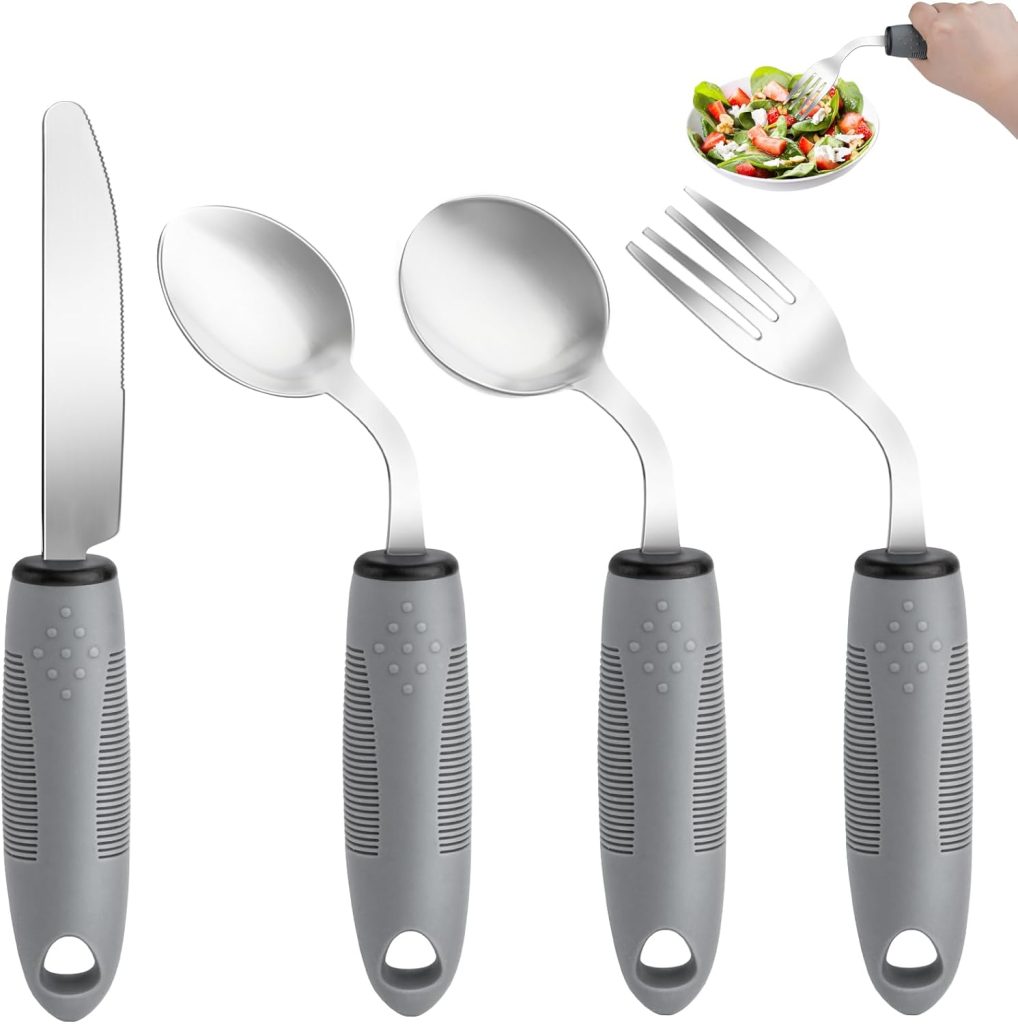
Stabilizing spoons with gyroscopic technology represent the premium option for tremor control.
These battery-powered devices can reduce hand tremor at the spoon bowl by up to 70%, according to clinical studies.
While significantly more expensive than traditional weighted utensils, they can provide dramatic improvements in eating independence for individuals with severe tremors.
Some patients benefit from tremor-dampening gloves or wrist weights used in conjunction with standard utensils.
These accessories provide stability without requiring investment in specialized utensils and can be particularly useful during the early stages of the disease when tremors are mild to moderate.
Grip Enhancement Solutions
Built-up handle utensils address the grip difficulties associated with Parkinson’s disease by increasing the diameter of the handle and providing cushioned surfaces.
These utensils typically feature foam or rubber coating that compresses slightly under pressure, providing a secure grip without requiring significant hand strength.
Universal cuffs represent another approach to grip difficulties, particularly for individuals with severe hand weakness or contractures.
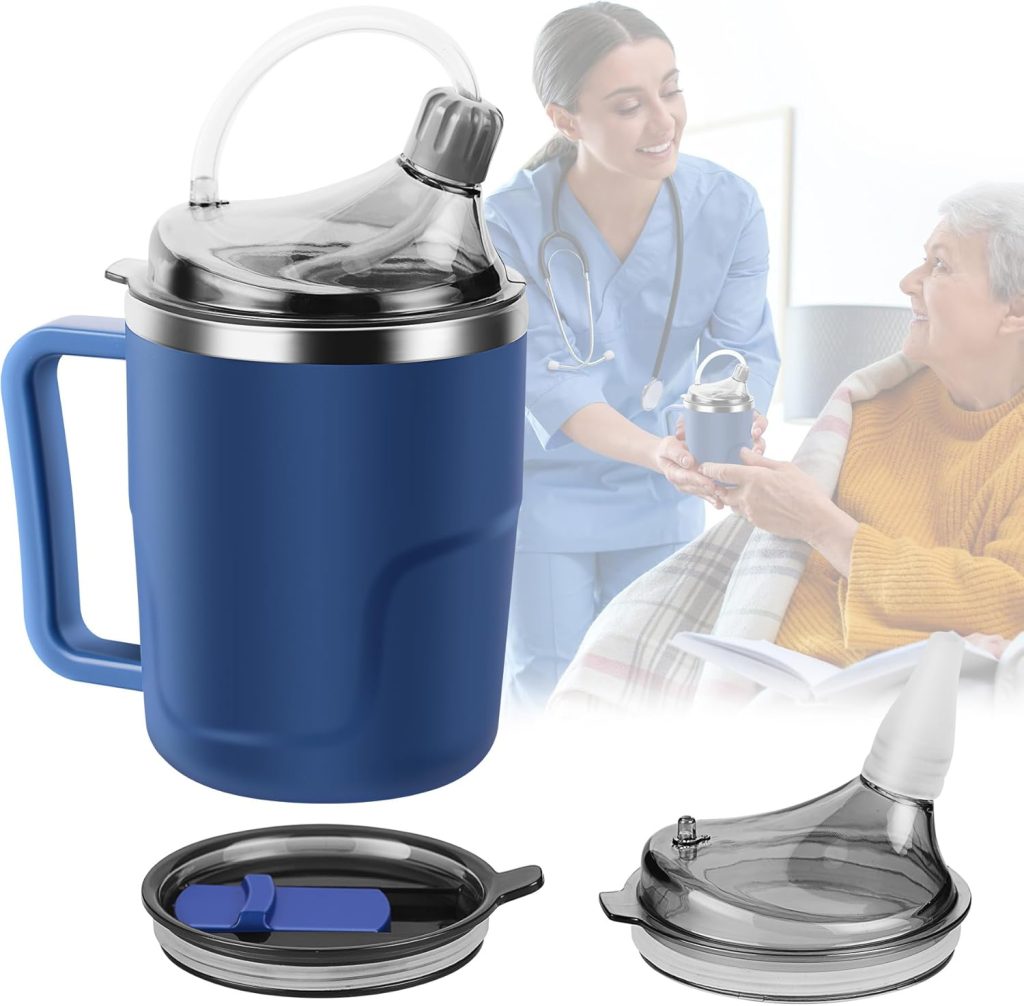
These devices strap around the hand and hold the utensil in place, eliminating the need for active gripping while still allowing for controlled movement.
Angled utensils can reduce the wrist motion required for eating, which is particularly beneficial for individuals with rigidity affecting wrist flexibility.
These utensils are bent at optimal angles to bring food to the mouth with minimal wrist deviation, reducing strain and improving comfort during meals.
Cutting and Food Preparation Aids
Rocker knives eliminate the need for coordinated two-handed cutting motions, which can be particularly challenging for Parkinson’s patients.
These knives use a rocking motion rather than a sawing motion, allowing for effective food cutting with one hand while providing stability and control.
Adaptive cutting boards with raised edges and non-slip surfaces create a stable work surface for food preparation.
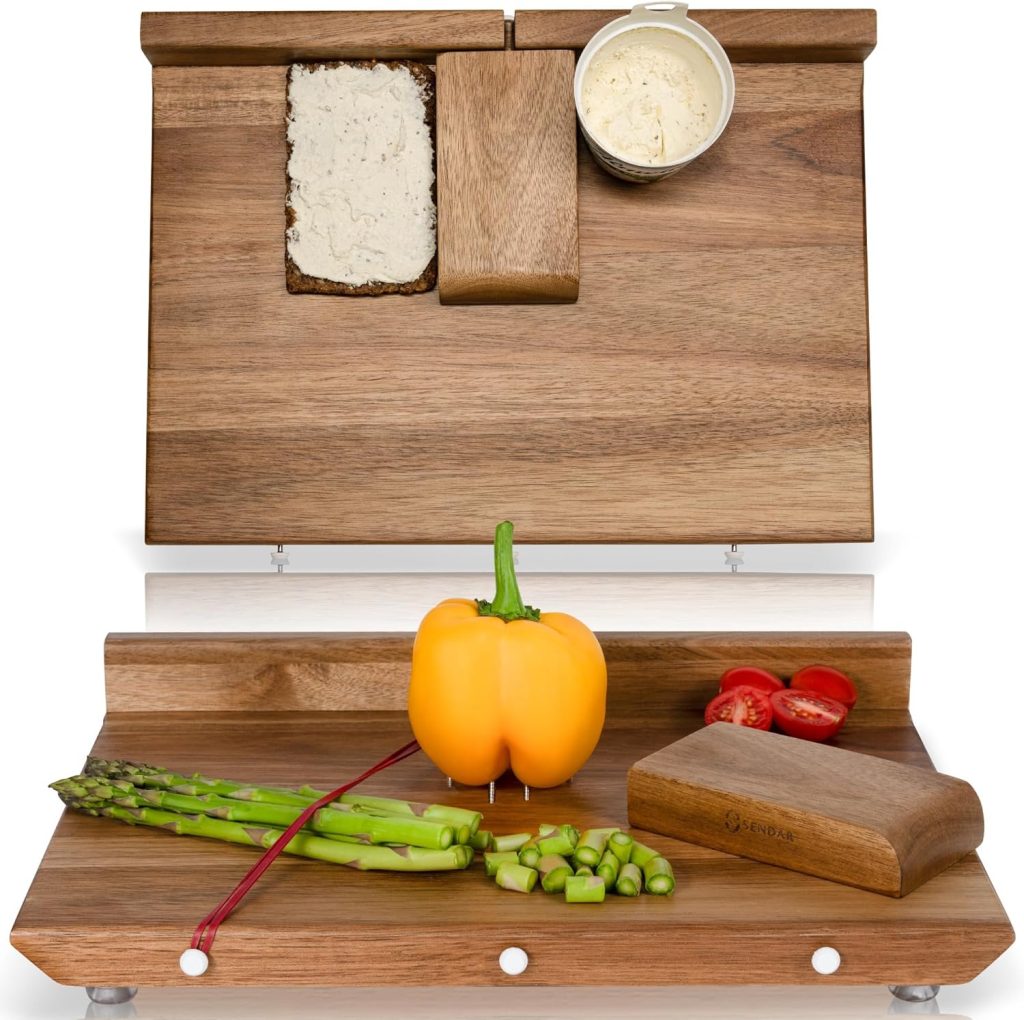
Some designs include corner guards and suction cup bases that prevent the board from sliding during use.
These features are particularly important for individuals with tremors who need additional stability during cutting tasks.
Plate guards and food bumpers can transform regular plates into adaptive dining aids by preventing food from sliding off during eating.
These removable accessories are particularly useful for individuals who experience tremors or have difficulty with precise utensil control.
Drinking Solutions
Weighted cups and mugs provide stability for individuals with tremors while drinking.
The additional weight, combined with ergonomic handle designs, can significantly reduce spilling and improve confidence during beverage consumption.
Spillproof lids and straws can prevent accidents and reduce anxiety about drinking in social situations.
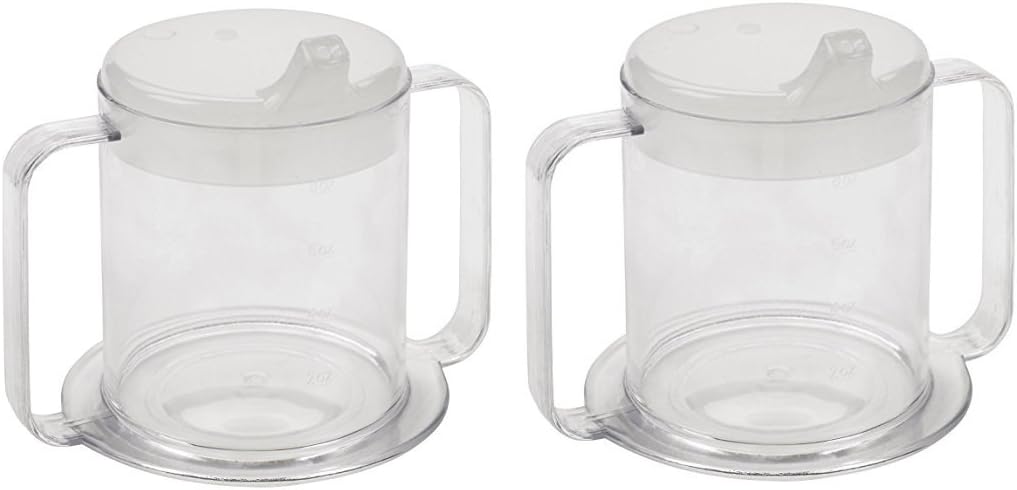
Modern designs are nearly indistinguishable from regular drinkware while providing the safety and security needed for independent drinking.
Two-handed cups with large handles accommodate the grip difficulties associated with Parkinson’s disease while providing the stability that comes from using both hands.
These cups often feature wide bases and spillproof designs that provide additional security during use.
OCCUPATIONAL THERAPY RECOMMENDATIONS BY DISEASE STAGE
The progressive nature of Parkinson’s disease requires adaptive equipment recommendations that evolve with changing symptoms and abilities.
Occupational therapists typically categorize recommendations based on disease stage, symptom severity, and individual functional capacity.
Early Stage Interventions
During the early stages of Parkinson’s disease, when symptoms are mild and primarily unilateral, occupational therapy focuses on maintaining existing skills while introducing adaptive strategies that will become more important as the disease progresses.
Equipment recommendations at this stage often include lightweight built-up handle utensils and basic stabilizing accessories.
The emphasis during early intervention is on establishing successful patterns and building confidence with adaptive equipment.
Patients who begin using adaptive utensils early in their disease course often have better long-term outcomes and greater acceptance of more specialized equipment as needs change.
Early stage recommendations also include education about energy conservation techniques, optimal meal timing in relation to medication schedules, and environmental modifications that will support continued independence as symptoms progress.
Moderate Stage Adaptations
As Parkinson’s disease progresses to moderate stages, characterized by bilateral symptoms and increasing motor difficulties, equipment recommendations become more specialized and comprehensive.
Weighted utensils often become necessary at this stage, and patients may require multiple adaptive solutions for different eating tasks.
The moderate stage is when many patients benefit most from comprehensive occupational therapy evaluation and equipment trials.
The combination of preserved cognitive function and increasing motor difficulties creates an optimal window for learning new adaptive techniques and accepting more specialized equipment.
Recommendations at this stage often include complete adaptive dining sets, environmental modifications such as specialized seating and table arrangements, and training in techniques that accommodate increasing symptoms while maintaining independence.
Advanced Stage Solutions
Advanced Parkinson’s disease requires the most specialized equipment and comprehensive support systems.
At this stage, safety becomes the primary concern, and equipment recommendations often include technology-enhanced solutions and comprehensive support systems.
Patients in advanced stages may require electronic stabilizing devices, modified food textures, and extensive environmental modifications.
The focus shifts from maintaining independence to ensuring safety while preserving as much autonomy as possible.
Advanced stage recommendations often involve interdisciplinary teams including occupational therapists, speech-language pathologists, and nutritionists to address the complex needs associated with advanced Parkinson’s disease.
DAILY LIVING INTEGRATION AND PRACTICAL STRATEGIES
Successfully integrating adaptive dining equipment into daily life requires more than simply purchasing specialized utensils.
The transition to using eating utensils for Parkinson’s requires thoughtful planning, gradual implementation, and ongoing adjustment as needs change.
Mealtime Routine Modifications
Establishing consistent mealtime routines that accommodate Parkinson’s symptoms can significantly improve the success of adaptive equipment use.
This includes timing meals with medication peaks when possible, allowing adequate time for eating without rushing, and creating a calm, distraction-free environment that supports concentration on eating tasks.
Many patients benefit from smaller, more frequent meals rather than three large meals per day.
This approach reduces fatigue and accommodates the slower eating pace that often accompanies Parkinson’s disease.
Adaptive utensils work more effectively when patients are not rushed or overly fatigued.
The social aspects of dining deserve special consideration.
Family members and caregivers should be educated about the proper use of adaptive equipment and the importance of maintaining dignity and independence during meals.
This education helps create supportive environments that encourage continued use of adaptive solutions.
Environmental Considerations
The dining environment plays a crucial role in the effectiveness of adaptive equipment.
Proper lighting is essential for individuals with Parkinson’s disease, who may experience visual changes that affect their ability to see food clearly.
Adjustable lighting that can be optimized for different times of day and meal types enhances the effectiveness of adaptive utensils.
Seating arrangements should provide adequate support and positioning for safe swallowing and comfortable utensil use.
This may include chairs with arms for stability, appropriate table height, and positioning that allows for optimal reach and manipulation of adaptive equipment.
Noise reduction in the dining environment can help individuals with Parkinson’s disease concentrate on eating tasks and reduce the cognitive load associated with using adaptive equipment.
This is particularly important for individuals experiencing cognitive changes that affect attention and concentration.
Caregiver Training and Support
Effective use of adaptive dining equipment often requires caregiver training and support.
Caregivers should understand the proper use of equipment, cleaning and maintenance requirements, and how to assist without taking over tasks that the individual can still perform independently.
The balance between assistance and independence is crucial in Parkinson’s care.
Caregivers should be trained to recognize when help is needed and when stepping back allows for greater independence.
This balance often changes as the disease progresses, requiring ongoing communication and adjustment.
Caregivers should also be educated about the emotional aspects of dining difficulties and the importance of maintaining dignity and choice in food selection and eating methods.
This understanding helps create supportive environments that encourage continued use of adaptive solutions.
COST CONSIDERATIONS AND INSURANCE COVERAGE
The financial aspects of acquiring appropriate eating utensils for Parkinson’s patients involve understanding insurance coverage, budgeting for progressive needs, and identifying cost-effective solutions that provide long-term value.
Budget-Friendly Alternatives
For individuals without insurance coverage or those seeking cost-effective solutions, several budget-friendly alternatives can provide significant benefits.
Basic built-up handle utensils, foam padding for existing utensils, and simple plate guards can address many dining challenges at a fraction of the cost of specialized equipment.
Many adaptive features can be added to existing utensils through modifications and accessories.
Foam tubing can be used to build up handles, rubber grips can be added for better control, and simple weights can be attached to provide tremor-dampening effects.
Community resources, including loan closets operated by Parkinson’s organizations and occupational therapy programs, may provide access to adaptive equipment for trial periods or temporary use.
These resources can be particularly valuable for evaluating equipment before purchase or for addressing short-term needs.
LOOKING FORWARD: MAINTAINING INDEPENDENCE AND QUALITY OF LIFE
The journey with Parkinson’s disease and dining challenges is highly individual, requiring ongoing assessment, adaptation, and support.
The key to successful management lies in proactive planning, professional guidance, and a willingness to adapt as needs change.
Regular occupational therapy evaluations can help ensure that adaptive equipment continues to meet changing needs and that new solutions are introduced as they become beneficial.
This ongoing relationship with healthcare providers helps maintain optimal function and safety throughout the disease course.
The field of adaptive dining equipment continues to evolve, with new technologies and design innovations regularly becoming available.
Staying informed about new options and maintaining relationships with occupational therapists and other healthcare providers helps ensure access to the most current and effective solutions.
Perhaps most importantly, the use of adaptive dining equipment should be viewed as a tool for maintaining independence and quality of life rather than a symbol of limitation.
The best eating utensils for Parkinson’s patients are those that allow individuals to continue enjoying meals safely and independently, preserving the social and nutritional aspects of dining that are so important to overall well-being.
The investment in appropriate adaptive dining equipment pays dividends in maintained independence, improved nutrition, enhanced safety, and preserved dignity.
For individuals with Parkinson’s disease and their families, these benefits represent not just practical improvements but fundamental contributions to quality of life and continued participation in the social and cultural significance of shared meals.
By understanding the challenges, exploring the solutions, and working with healthcare professionals to implement appropriate interventions, individuals with Parkinson’s disease can continue to enjoy safe, independent, and dignified dining experiences throughout their journey with this condition.
The right combination of adaptive equipment, professional guidance, and supportive environments can help ensure that mealtimes remain a source of nourishment, pleasure, and social connection rather than frustration and anxiety.
This article is for informational purposes only and should not replace professional medical advice. Individuals with Parkinson’s disease should consult with their healthcare providers, including occupational therapists, to determine the most appropriate adaptive equipment for their specific needs and circumstances.